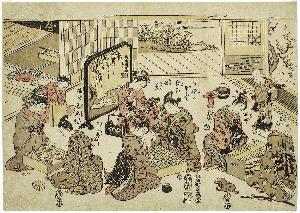Torii Kiyomitsu
Kamejirō;Torii Kiyomitsu
Place: Edo
Born: 1735
Death: 1785
Biography:
Torii Kiyomitsu was a renowned Japanese painter and printmaker of the Torii school of ukiyo-e art, which flourished from the 17th to the 19th centuries. Born in 1735, Kiyomitsu was the son of Torii Kiyonobu II or Torii Kiyomasu II and became the third head of the Torii school. He was originally called Kamejirō before taking the gō Kiyomitsu.
Artistic Style and Techniques
Kiyomitsu's work primarily focused on actor prints and bijinga (pictures of beautiful women), using the benizuri-e technique, which involved using one or two colors of ink on the woodblocks. He later introduced full-color prints in 1765, which became a hallmark of his style. His prints often featured a "dream-like quality" and were praised for their beauty and elegance. Ukiyo-e art, which translates to 'picture[s] of the floating world', reflected the hedonistic lifestyle of Japan's Edo period (1603–1868). Kiyomitsu's work was influenced by this movement, and he became one of the leading artists of his time. His pupils, including Torii Kiyotsune and Torii Kiyonaga, went on to become masters in their own right.
Notable Works and Legacy
Kiyomitsu's notable works include his actor prints and bijinga, which can be found in various museums, including the Kupferstichkabinett (Berlin, Germany). His legacy extends beyond his own work, as he played a significant role in shaping the Torii school style. Kiyomitsu's influence can also be seen in the works of other artists, such as Suzuki Harunobu, who was just beginning his career during Kiyomitsu's time.
- Visit The Ukiyo-e Art Movement to learn more about the history and techniques of ukiyo-e art.
- Explore the works of other notable artists, such as Ando Hiroshige and Katsushika Hokusai, at The Ukiyo-e Art Movement.
- Discover the Torii Kiyomitsu collection at Wikioo.org.
Kiyomitsu's contributions to Japanese art and ukiyo-e are undeniable, and his legacy continues to inspire artists and art enthusiasts today. His work can be found in various museums and collections, including the Wikioo.org collection. For more information on Kiyomitsu and other notable artists, visit Wikipedia.

